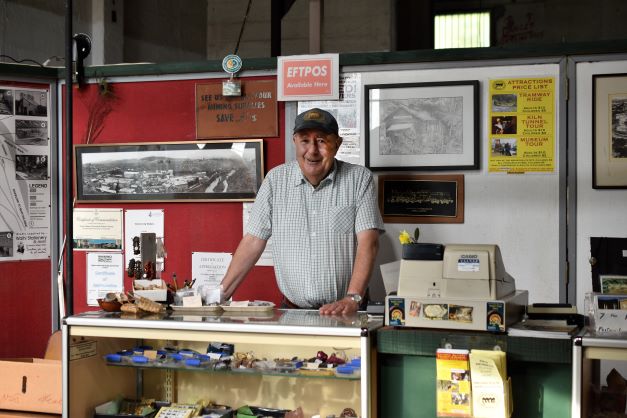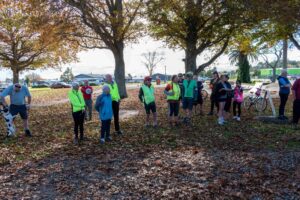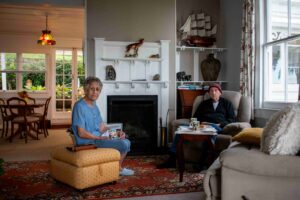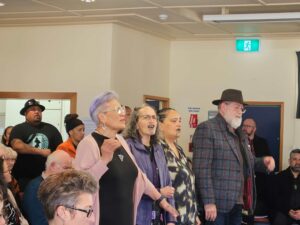In a time-worn, antiquated room filled with the rusting relics of yesteryear, George Capper is settled comfortably in a chair, resident feline Blackie curled up on his lap.
This is the Victoria Battery Tramway and Museum in Waikino, and 85-year-old George is one of its most dedicated volunteers.
Beside him at the large-screen computer station sits the society’s chairperson, Kerry Single.

The pair are dusty detectives, pouring over blown-up images of old photographs. The rise of digital tools has been a boon for them, revealing details not easily visible to the naked eye.
“We’ve got such a lot of history within the photographs we’ve got here,” Kerry says.
“You blow those photographs up and you can see things that you couldn’t see before.”
The society was formed in 1994 with the aim of promoting and educating the public about the rich history of the area. George joined the society in 1998 after moving to Waihī, and has had a hand in almost every role since.
“If it wasn’t for George and what he’s actually done for the society over the years, the place wouldn’t have continued. He’s been chairman, president, secretary, treasurer, committee, general dogsbody; and anything else that nobody wants to do, it’s George,” Kerry says.
“He would never admit to that, but it’s a fact.” When George first set foot on the site, he says, there was nothing there but a bit of rubbish. The old transformer building still stood of course, between the ore kilns at the top of the hill and the cyanide tank ruins bordering the river, but the rest of the site was gorse and grass.
“They had the battery’s locomotives just sitting on the concrete,” George says. “We put rails down and I drove the spikes into the sleepers. The next time we came out I helped put one of the locomotives off the concrete up on to the rails … it sort of went from there.”
These days there is an operating light-gauge railway through the site, as well as a museum inside the old transformer building where George now sits.
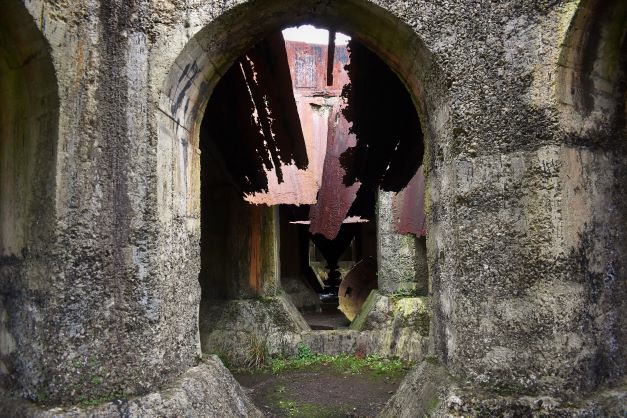
Among the displays and photos are shelves of tools, crockery and equipment. One of the original 100 stampers towers toward the ceiling; a mining skip rests in the opposite corner.
The artefacts were “begged, borrowed, stolen and otherwise acquired”, Kerry says, and they show much of the local history of the battery itself – how gold was extracted from quartz; the evolution of buildings at the site as technologies progressed; what day-to-day life and work was like.
George says many of the irreplaceable artefacts are things saved from the rubbish – he once had someone bring in a box destined for kindling.
“He said, ‘here, you can have them’, and now we’ve got all these little patterns.”
“[They’re] used to make the moulds to make the castings of the steel objects that were then formed into wheels, gears, pulleys, all sorts of things,” Kerry adds.
“There wasn’t much they couldn’t make here. Typical Kiwi ingenuity, they bring machinery in from overseas and alter it with a piece of number eight wire to make it work how we wanted it to.”
Information about the past is everywhere – including in the heads of its volunteers.
“This place was for many years the biggest producer of gold in the southern hemisphere,” Kerry says. “The records show it produced something like 35 and a half million ounces of gold in its time.”
“This battery was the second largest gold processing plant in the world, so we believe,” adds George.
The men continue talking as they pull out photo after photo – they have decades worth of knowledge to pass on.
As Kerry says, there’s nobody better to run the museum than those who helped put it together in the first place.
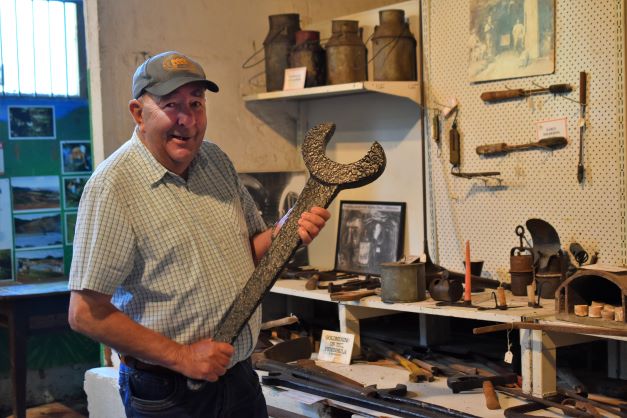
These days, George spends his time at the museum in a variety of ways.
“I’m on the counter, I take the entrance money,” he says. “I might start a museum tour or arrange someone to do the train trip or kilns.
“If there’s nobody around, I’ll mow the grass, weedeat … do a bit of dusting. Feed the cat, and that’s what I do.”
In fact, George pops in every day to see to Blackie the cat, who’s lived at the site since his litter was dumped there about 12 years ago.
The feline’s a much-loved member of staff, even helping out with customers from time to time.
“Over the Christmas period I … was by myself and the cats helped me,” George says.
“I’d be showing people through and I’d turn around and there’d be the black one looking at me. ‘What’s wrong Blackie?’ and I’d walk out to the counter and there would be people there.”
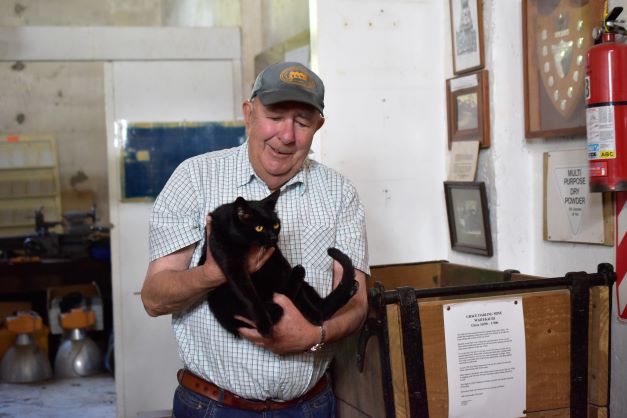
There aren’t always a lot of people here at the museum – they’ve been struggling to attract volunteers.
“We’ve got a regular core of around five or six of us that are out here,” Kerry says. “We can’t get the people to operate, so we’re open mostly on the weekends.”
They have plenty of help from people with engineering, mechanical or other specialised skills.
“But we want general Joe Bloggs as well, who’s interested in the history, who can
come in prepared to learn [and] relate that history to our visitors and guests.”
Kerry says their aim is to preserve and maintain the history of the Victoria Battery.
“It’s got a significant history as far as New Zealand and the industrial industry is concerned,” he says.
As for George? He’s had a lot of satisfaction in volunteering and seeing the society grow over the years.
“[But] every time I think oh, I’ll give it up, something happens and I have to stay on because we haven’t got enough volunteers. So I’m sort of stuck,” he says.
“If we can get enough people to give us old fellas a bit of a rest occasionally, that would be lovely,” adds Kerry.
“We’re – average age [of] probably around 70. We’re kind of limited to how much more we’ve got.”
The Victoria Battery tramway and museum is located in Waikino, and is open 10am-3pm on Saturdays, Sundays and public holidays. To get involved contact Volunteering Waikato at volunteeringwaikato.org.nz.
By ALICE PARMINTER, Public Interest Journalism funded by NZ on Air.

